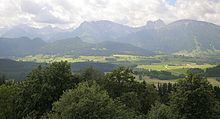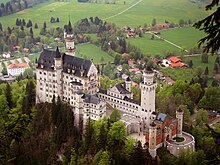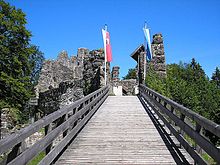Allgäu castle region
The castle Allgäu region includes 38 castles and fortifications in the Bavarian Allgäu and Mittelschwaben . The planning concept was developed from 2004 as part of an EU LEADER + project . The development of the recorded facilities, which was begun under the technical direction of the medieval archaeologist Joachim Zeune , is intended to enable a scientific analysis of the castle region, which has so far received little attention from experts. In addition, a Europe-wide marketing concept for the tourist development of the objects was developed.
The castle region
The Allgäu and the central Swabian district of Unterallgäu were until about 1989/90 as one of the most poorly developed regions in Bavaria in terms of castle history . The few available overview works and castle monographs contained numerous inaccuracies and misinterpretations. It was only around 1990 that experts began to deal more seriously with the neglected castle landscape around the two fairy tale castles Neuschwanstein and Hohenschwangau . Even the two large castle ruins Hohenfreyberg and Eisenberg near Pfronten received little national public attention.
In connection with the renovation of the Hohenfreyberg castle ruins, the conception of the Ostallgäu-Ausserfern castle region began in 1998 . The small project was initiated mainly to improve the tourist development of the castle complexes around Füssen and Reutte . However, the measures were limited to the setting up of information boards and the publication of a comprehensive brochure.
The "Castle Region Ostallgäu-Ausserfern" was surprisingly well received. Around Ehrenberg Castle near Reutte a “world of castles” even developed, which also includes the early modern fortifications Schlosskopf and Fort Claudia above the medieval fortress . One of the largest historical festivals in Central Europe takes place every year on the grounds of the hermitage below the ensemble (Ehrenberger Zeit).
In 2004/05 there was also the opportunity to extend the castle region to the entire Bavarian Allgäu and southern Central Swabia via a LEADER + project. The “Allgäu Castle Region” was developed by the Joachim Zeune Castle Office in collaboration with the designer Andreas Koop. The measures to develop the castle region were coordinated with three districts and 23 project participants and implemented in cooperation with regional craft businesses .
However, the concept only includes 38 of the approximately 300 verifiable medieval castle sites in the Allgäu and southern Central Swabia. Some of the most important castles in the region could not be integrated, primarily for reasons of ownership. The castle ruins Helmishofen and Rettenberg and the Motte von Dietmannsried are missing in the catalog of the castle region. The numerous prehistoric and early historical and early medieval hill castles and high medieval castle stables in the hill country in front of the Allgäu , Lechtal and Ammergau Alps were largely ignored .
The catalog of measures
In the area of the castle complexes, bilingual, illustrated information boards (German / English) provide basic information about the respective objects. Depending on the size and importance of the object, several such boards were sometimes set up. In addition, some small didactic productions were created. For this purpose, the arming holes of some ruins (Hohenfreyberg, Alttrauchburg) were reactivated by hanging in small scaffolding , which were provided with flat figures of "stone setter". These presentations illustrate the former function of such small openings in the masonry as scaffolding girders. Similar flat figures of hook rifle shooters stand or kneel in some loopholes (Hohenfreyberg, Laubenbergerstein , Hohes Schloss Füssen ) and on the battlements of the city wall at Mindelheim .
Two reversible, i.e. listed, viewing platforms were installed on the Falkenstein and Hohenfreyberg castles, which allow the visitor to enjoy spectacular panoramic views.
Fully plastic castle models in the local museums show Falkenstein Castle (around 1270), Neuchâtel near Durach (around 1600) and the Motte near Seeg (around 1200). Other systems were visualized as virtual reconstructions and published on flyers , on the Internet or on the information boards.
During some castle renovations, interested parties were able to participate in excavations or renovation work on a daily basis and thus gain an insight into the monument conservation practice of castle research. In 2007, an additional construction site was set up. In the course of this measure, the small castle ruins of Schöneberg near Betzigau could be saved from final departure.
Two medieval playgrounds have been set up near Alttrauchburg Castle and in Mindelheim. Below the Falkenstein Castle, the most elaborate such facility was built, the “Greifenstein Castle”. Here, a slightly scaled-down replica of a high medieval tower hill castle is intended to provide children and young people with basic knowledge about castle history. In addition to a "Stechbahn" with a pedal-driven wooden horse, a climbing wall from plain and humpback blocks , rockers and loose webs one of the playground also offers a bow shooting ground , which is, however used only under supervision.
An internet platform has been set up for supraregional advertising for the castle region. Currently, however, the offer only offers basic information about the 38 palaces, castles and city fortifications.
In total, the total financial volume of the “Burgenregion Allgäu” project was over 650,000 euros , of which 300,000 euros were covered by funding.
The castles, palaces and city fortifications
Castles
- Bad Grönenbach High Castle
- Castle Hohenschwangau
- Füssen High Castle
- Hopferau Castle
- Kronburg Castle
- Mindelburg
- Neuschwanstein Castle
- Weizern Castle
ruins
- Old and New Kalden Castle
- Alttrauchburg Castle
- Burgberg Castle
- Burghalde Kempten
- Eisenberg Castle
- Falkenstein Castle
- Fluhenstein Castle
- Hohenfreyberg Castle
- Hopfen Castle
- Hugofels Castle
- Kemnat Castle
- Langenegg Castle
- Laubenbergerstein Castle
- Nesselburg Castle
- Neuchâtel Castle
- Rauhlaubenberg Castle
- Rothenfels Castle
- Rothenstein Castle
- Schöneberg Castle
- Sulzberg Castle
- Wagegg Castle
- Werdenstein Castle
- Wolkenberg Castle
Castle stables
City fortifications
Castle types
The 38 objects in the castle region encompass almost all important castle types from the High and Late Middle Ages. The most important parts of the castle history can therefore be studied almost completely within an area of around 50 × 50 km.
The well-preserved Motte in Seeg-Burk represents early high medieval castle building. The foundations of a stone tower castle from around 1070 have been preserved via Hopfen am See near Füssen. High medieval tower castles from a somewhat later period are or were the predecessor castles of Neuschwanstein Castle, the ruins of Burgberg and Sulzberg. Younger residential towers can be found on the Burghalde Kempten and in Langenegg.
The main tower of Hugofels Castle near Immenstadt (beginning of the 13th century) is an important donjon of Franco-Swiss character . "Fixed houses" from this era stand on the castles Falkenstein and Alttrauchburg.
The castles Laubenbergerstein, Neuchâtel, Sulzberg, Wolkenberg and Kemnat illustrate the classic high medieval castle construction. These systems each had a palace and a massive keep and were of a circular wall surrounded.
Strong shield walls from the late 13th century protected the Nesselburg over Nesselwang and Grönenbach Castle. Around 1306 a mighty shield wall was built on the Alttrauchburg. The small, conceptually related "compact castle" Fluhenstein was not built until 1360.
The rather rare building type of the walled castle was used in the early 14th century to build Eisenberg Castle. Together with Hohenfreyberg Castle, which is just five minutes' walk away, the castle forms one of the most important groups of castles in Central Europe. This late construction of the new castle is actually an anachronism . The fortress was not built until the end of the Middle Ages in the form of a high medieval hilltop castle from the Staufer era .
The mighty, albeit largely reconstructed, artillery tower on Laubenbergerstein dates from the middle of the 15th century and documents the attempt to keep pace with the rapid development of weapons technology in this era.
One of the most magnificent preserved late Gothic castle castles in Germany is the High Castle above Füssen with its colorful illusion paintings . The Kronburg is an early modern fort castle . An Italian style castle forms the core of Hohenschwangau Castle, which was redesigned in the 19th century.
The castles and hops and wheat are typical, only lightly fortified, smaller noble seats from the post-medieval era.
The two world-famous royal castles Neuschwanstein and Hohenschwangau under the Säuling, the distinctive border mountain between Upper Bavaria , Swabia and Tyrol, are the highlights of the castle romance of the 19th century .
The city fortifications of Füssen, Kaufbeuren, Kempten and Mindelheim were expanded in the late Middle Ages to make them suitable for artillery. Long stretches of the wall with battlements have been preserved, especially in Füssen and Kaufbeuren.
In the neighboring Ausserfern there are also characteristic examples of other types of fortifications such as the small cave castle Loch near Unterpinswang and the huge system of fortifications around Ehrenberg Castle near Reutte. Above Vils, there is a mighty Hohenstaufen, temporarily habitable keep on a rock head above the Vilstal ( Vilsegg Castle ).
literature
- Toni Nessler: Castles in the Allgäu . 2 vols. Kempten, Allgäuer Zeitungsverlag, 1985
- 1: Castle ruins in the Altlandkreis Kempten and Altlandkreis Sonthofen . ISBN 3-88006-102-5
- 2: Castle ruins in the West Allgäu and bordering Vorarlberg, in the Württemberg Allgäu, in the northern Allgäu around Memmingen, in the northeast Allgäu around Kaufbeuren and Obergünzburg as well as in the eastern Allgäu and in the adjacent Tyrol . ISBN 3-88006-115-7
- Oswald Trapp: Tiroler Burgenbuch, VII, Oberinntal and Ausserfern . Athesia publishing house, Bozen 1986, ISBN 88-7014-391-0
- Alexander Seidlich: Die Burgenregion Allgäu (diploma thesis Georg-August-Universität Göttingen, 2006). Online: http://www.regionalentwicklung-oberallgaeu.de/download/diplomarbeit.pdf
- Joachim Zeune: Castle Guide Ostallgäu and Ausserfern, Tyrol . Marktoberdorf 1998
- Joachim Zeune: Castle renovations in the Allgäu. Part 2 of the horror balance . In: Schönere Heimat , 1992, 1, pp. 7-20
- Joachim Zeune: Allgäu Castle Region . 2008
- Joachim Zeune: The Leader + project “Burgenregion Allgäu” - a catalog of measures for the serious tourist development of an unknown castle landscape . In: Burgen und Schlösser - Journal for Castle Research and Monument Preservation , 2009, 1






